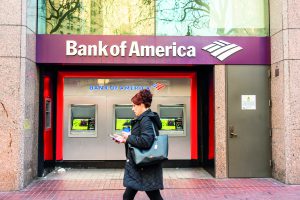BLOOMBERG
Bank of America Corp (BofA) first-quarter profit beat estimates after its fixed-income traders delivered a windfall large enough to cover the rising cost of the bank’s souring loans.
Revenue from fixed-income, currencies and commodities trading unexpectedly rose almost 30% to $3.4 billion in the first quarter, as clients reacted to changing interest rates, the bank said. That helped the bank top analysts’ estimates for earnings per share.
Net interest income (NII), a key source of revenue for the bank, rose 25% to $14.4 billion in the first three months of the year. Analysts had expected a 24% increase for NII, the revenue collected from loan payments minus what depositors are paid.
“Revenue growth reflected strong net interest income improvement coupled with one of our best quarters of sales and trading,†Chief Financial Officer Alastair Borthwick said in a statement.
The bank’s traders beat estimates, with overall trading up 9% to $5.1 billion. Equities posted a 19% decline to $1.6 billion. The first quarter saw dramatic market swings tied to rate hikes, surging inflation and recession fears.
The results offer another look at how Wall Street fared through a tumultuous quarter that saw the collapse of three smaller, regional lenders. JPMorgan Chase & Co, Morgan Stanley, Citigroup Inc and Wells Fargo & Co all posted gains in net interest income, with some also raising their forecasts for the rest of the year.
Shares of Charlotte, North Carolina-based Bank of America, which were down 8.3% this year rose 2.3% in early New York trading.
Deposits fell less than expected as customers piled into the biggest US bank after the collapse of three smaller firms. The lender had $1.91 trillion in deposits at the end of March, compared with analysts’ estimates of $1.88 trillion. That means that an influx of clients seeking safety countered outflows from inflation and customers seeking higher-yielding alternatives.
Bank of America’s non-interest expenses rose 6% from a year earlier to $16.2 billion. Costs have been a focal point for investors, with persistent inflation putting pressure on spending and spurring wage growth.
 The Gulf Time Newspaper One of the finest business newspapers in the UAE brought to you by our professional writers and editors.
The Gulf Time Newspaper One of the finest business newspapers in the UAE brought to you by our professional writers and editors.
